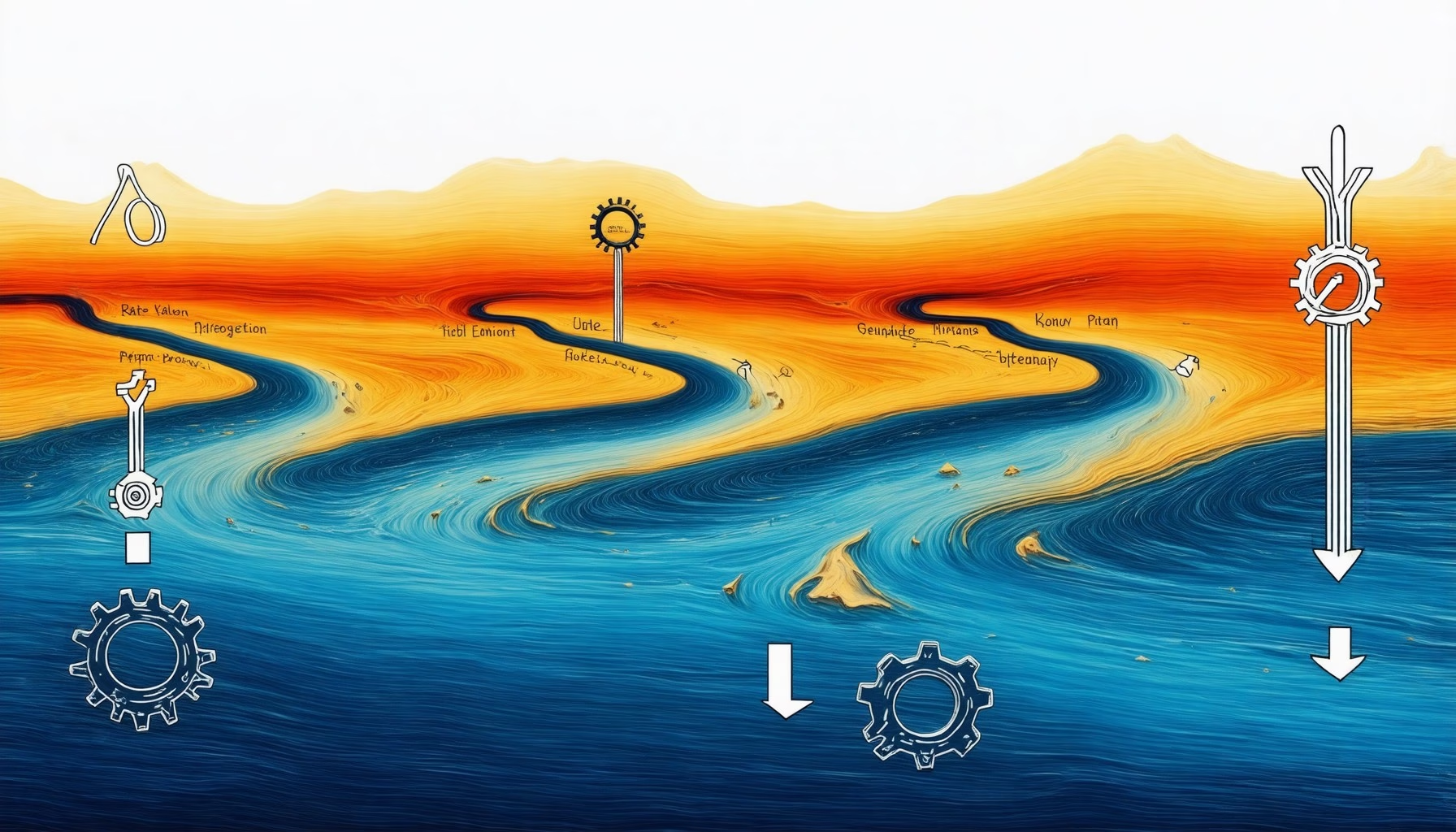Puntos Clave
- Entender el Proceso del Pipeline de Ventas: Domina las cinco etapas clave—Generación de Leads, Calificación de Leads, Contacto Inicial, Presentación y Negociación—para optimizar tus estrategias de ventas.
- Utiliza Estrategias de Gestión Efectivas: Implementa una plantilla de etapas del pipeline de ventas para rastrear el progreso y mejorar la visibilidad para una mejor responsabilidad del equipo.
- Aprovecha la Tecnología: Herramientas como Salesforce optimizan el proceso de gestión del pipeline de ventas, proporcionando información y automatizando tareas para aumentar la eficiencia.
- Monitorea Métricas Clave: Evalúa regularmente las etapas del pipeline de ventas y los porcentajes de probabilidad asociados para prever ingresos y refinar tu enfoque.
- Adapta y Optimiza: Revisa continuamente tu proceso del pipeline de ventas para identificar cuellos de botella y mejorar las tasas de conversión, asegurando un crecimiento empresarial sostenido.
Bienvenido a nuestra guía completa sobre cómo dominar el proceso del pipeline de ventas, donde profundizaremos en las etapas esenciales, estructuras y estrategias de gestión efectivas que pueden elevar tu juego de ventas. Entender el flujo del proceso del pipeline de ventas es crucial para cualquier negocio que busque optimizar sus esfuerzos de ventas. En este artículo, exploraremos las cinco etapas clave del pipeline de ventas, compararemos el pipeline de ventas vs embudo de ventas, y proporcionaremos una visión general detallada de los pasos del proceso del pipeline de ventas. Además, discutiremos aplicaciones del mundo real a través de ejemplos de etapas del pipeline de ventas y ofreceremos consejos prácticos para crear una plantilla de etapas del pipeline de ventas que se adapte a tus necesidades. Al final de esta guía, no solo comprenderás las complejidades del proceso de gestión del pipeline de ventas sino que también obtendrás información sobre las métricas que importan, como etapas del pipeline de ventas y porcentajes de probabilidad. Únete a nosotros mientras navegamos a través de las complejidades del embudo del proceso de ventas en Salesforce y te equipamos con las herramientas necesarias para el éxito en el competitivo panorama actual.
¿Cuáles son las 5 etapas del pipeline de ventas?
El pipeline de ventas es un proceso estructurado que describe las etapas por las que pasa un cliente potencial desde la conciencia inicial hasta la compra final. Entender estas etapas es crucial para optimizar las estrategias de ventas y mejorar las tasas de conversión. Aquí están las cinco etapas clave del pipeline de ventas:
Understanding the Sales Pipeline Process Flow
- Generación de clientes potenciales: This is the initial stage where potential customers are identified. Techniques such as content marketing, social media outreach, and networking events are commonly used to attract leads. According to HubSpot, effective lead generation strategies can significantly increase the quality and quantity of prospects.
- Calificación de Leads: In this stage, leads are evaluated to determine their potential as customers. This involves assessing their needs, budget, and readiness to buy. Tools like lead scoring can help prioritize leads based on their likelihood to convert. Research from the American Marketing Association indicates that properly qualified leads can improve sales efficiency by up to 50%.
- Initial Contact: Once leads are qualified, the next step is to make initial contact. This can be done through emails, phone calls, or social media messages. Personalization is key here; tailoring communication to the specific needs of the lead can enhance engagement. A study by Salesforce found that personalized outreach increases response rates significantly.
- Presentation or Demo: At this stage, the sales team presents the product or service to the lead, often through demonstrations or detailed presentations. This is an opportunity to showcase the value proposition and address any questions or concerns. According to research from the Corporate Executive Board, effective presentations can increase the likelihood of closing a deal by 70%.
- Negotiation and Closing: The final stage involves negotiating terms and finalizing the sale. This may include discussing pricing, contracts, and addressing any last-minute objections. Effective negotiation skills are essential here, as they can lead to a successful close. A report by McKinsey highlights that strong negotiation tactics can lead to higher sales margins and customer satisfaction.
Sales Pipeline Stages Explained: A Deep Dive
By understanding and optimizing each stage of the sales pipeline, businesses can enhance their sales processes and improve overall performance. For further insights, consider exploring resources from reputable sales training organizations and industry blogs. Additionally, utilizing a plantilla de etapas del pipeline de ventas can help streamline your approach, making it easier to track progress and adjust strategies as needed.
What is the pipeline method of sales?
The pipeline method of sales is a structured approach that outlines the specific stages a prospect goes through in the sales process, from initial contact to closing the deal. This method is crucial for sales teams as it provides a clear framework for managing leads and forecasting revenue. Here’s a breakdown of the key components of the sales pipeline:
- Generación de clientes potenciales: This is the first stage where potential customers are identified through various channels such as social media, email marketing, and networking events. Effective lead generation strategies can significantly enhance the quality of prospects entering the pipeline.
- Qualification: In this stage, sales representatives assess the leads to determine their potential as customers. This involves evaluating their needs, budget, and readiness to purchase. Tools like CRM software can assist in tracking lead information and interactions.
- Proposal: Once a lead is qualified, a tailored proposal is presented. This document should address the specific needs of the prospect and outline how the product or service can solve their problems. Personalization at this stage is key to increasing conversion rates.
- Negociación: After the proposal, discussions may lead to negotiations regarding pricing, terms, and conditions. This stage requires strong communication skills and the ability to address objections effectively.
- Closing: This is the final stage where the deal is finalized. Sales reps must ensure that all agreements are clearly understood and documented. Techniques such as trial closes can help gauge the prospect’s readiness to commit.
- Follow-Up: Post-sale follow-up is essential for customer retention and can lead to upselling opportunities. Maintaining a relationship with the customer can enhance loyalty and encourage referrals.
Incorporar herramientas como Bots de Messenger can streamline communication during the sales pipeline, providing instant responses to inquiries and nurturing leads through automated interactions. According to a study by HubSpot, companies that utilize chatbots can increase lead conversion rates by up to 30%.
Comparing Sales Pipeline vs Sales Funnel
Understanding the difference between the sales pipeline and the sales funnel is essential for effective sales strategy development. While both concepts aim to guide prospects through the buying journey, they serve different purposes. The sales pipeline focuses on the stages of the sales process, tracking the progress of leads from initial contact to closing. In contrast, the sales funnel emphasizes the overall customer journey, illustrating how many leads enter at the top and how many convert at each stage.
For example, a sales pipeline might include stages such as lead generation, qualification, proposal, negotiation, closing, and follow-up, while a sales funnel visualizes the decreasing number of leads as they move through these stages. Understanding this distinction can help sales teams tailor their strategies effectively, ensuring they address the specific needs of prospects at each stage of the sales process.
The Importance of the Sales Pipeline Management Process
Effective sales pipeline management is crucial for maximizing revenue and improving sales efficiency. By regularly reviewing and optimizing the sales pipeline process flow, sales teams can identify bottlenecks, enhance lead qualification, and improve conversion rates. Utilizing tools like Salesforce can provide valuable insights into sales performance, helping teams make data-driven decisions.
Moreover, implementing a sales pipeline stages template can streamline the management process, allowing teams to visualize their progress and prioritize leads effectively. This structured approach not only enhances productivity but also fosters better communication among team members, ensuring everyone is aligned on goals and strategies.
For those looking to refine their sales pipeline management, resources such as Gartner y Forrester offer extensive research and insights into best practices and emerging trends in sales management.
What is the Pipeline Sales Process?
The proceso del pipeline de ventas is a systematic approach that outlines the steps a potential customer takes from the moment they become aware of a product or service until they make a purchase. Understanding this process is essential for businesses looking to enhance their sales strategies and improve conversion rates. The flujo del proceso del pipeline de ventas typically consists of several key stages, each requiring specific strategies to effectively guide prospects through their journey.
Sales Pipeline Process Steps: A Comprehensive Overview
The pasos del proceso del pipeline de ventas can be broken down into distinct phases, each playing a crucial role in converting leads into customers. Here’s a detailed look at these steps:
- Consciencia: This initial stage involves creating awareness about your product or service. Effective marketing strategies, such as content marketing and social media outreach, are vital here. According to HubSpot, 61% of marketers cite generating traffic and leads as their top challenge.
- Interés: Once potential customers are aware, they may show interest by engaging with your content. Providing valuable resources like whitepapers or webinars can nurture this interest. Research from the Content Marketing Institute indicates that 70% of consumers prefer learning about a company through articles rather than ads.
- Consideración: In this phase, prospects evaluate your offerings against competitors. It’s crucial to provide detailed product information, case studies, and testimonials to build trust. A study by Nielsen shows that 92% of consumers trust recommendations from friends and family over any other form of advertising.
- Intent: Here, prospects demonstrate a clear intent to purchase, often by adding products to their cart or requesting a quote. Utilizing tools like Messenger Bots can enhance customer interaction, providing immediate responses to inquiries and guiding them through the decision-making process.
- Evaluación: At this stage, prospects are making their final assessments. Offering personalized consultations or demos can be effective. According to a report by McKinsey, 70% of buying experiences are based on how the customer feels they are being treated.
- Compra: This is the final stage where the prospect becomes a customer. Ensuring a smooth transaction process and providing excellent customer service can lead to repeat business and referrals. Bain & Company states that increasing customer retention rates by just 5% can boost profits by 25% to 95%.
- Post-Purchase: After the sale, maintaining engagement through follow-ups and customer support is crucial. This stage significantly impacts customer loyalty and future sales opportunities.
Sales Process Funnel in Salesforce: Integration and Benefits
The embudo del proceso de ventas en Salesforce provides a robust framework for managing the sales pipeline effectively. By integrating Salesforce into your sales strategy, you can streamline the proceso de gestión del pipeline de ventas and gain valuable insights into each stage of the funnel. Salesforce allows for tracking of sales pipeline stages, enabling businesses to analyze performance and make data-driven decisions.
Some key benefits of using Salesforce for your sales pipeline include:
- Enhanced Visibility: Salesforce provides a clear view of where each prospect stands in the sales pipeline, allowing for timely follow-ups and adjustments to strategies.
- Automatización: Automating repetitive tasks frees up time for sales teams to focus on building relationships and closing deals.
- Análisis e informes: Salesforce offers powerful analytics tools that help businesses understand their sales performance and identify areas for improvement.
- Integración con otras herramientas: Salesforce can be integrated with various marketing and customer service tools, creating a seamless experience across platforms.
By leveraging the capabilities of Salesforce, businesses can optimize their flujo del proceso del pipeline de ventas and enhance their overall sales effectiveness.
What are the 7 stages of the sales process?
The seven stages of the sales process are essential for effectively converting leads into customers. Each stage plays a critical role in understanding and addressing the needs of potential clients. Here’s a detailed breakdown:
- Prospecting: This initial stage involves identifying potential customers who may have an interest in your product or service. Techniques include networking, referrals, and utilizing social media platforms to gather leads.
- Preparation: In this stage, sales professionals conduct thorough research on their prospects. Understanding the prospect’s industry, challenges, and needs is crucial. This preparation allows for a tailored approach during the sales process.
- Approach: The approach is about making the first contact with the prospect. This can be done through cold calls, emails, or in-person meetings. The goal is to establish rapport and set the tone for the conversation.
- Presentation: During the presentation stage, the salesperson showcases the product or service, highlighting its benefits and how it addresses the prospect’s specific needs. Utilizing visual aids and demonstrations can enhance engagement and understanding.
- Manejando Objeciones: Prospects may have concerns or objections regarding the product or service. This stage involves actively listening to these objections and providing clear, factual responses to alleviate any doubts. Effective objection handling can significantly influence the prospect’s decision-making process.
- Closing: This critical stage involves asking for the sale. Sales professionals should be prepared to summarize the benefits and address any final concerns. Techniques such as trial closes can help gauge the prospect’s readiness to commit.
- Follow-Up: After closing the sale, follow-up is essential for maintaining the relationship and ensuring customer satisfaction. This can include checking in on the product’s performance, addressing any issues, and exploring opportunities for upselling or referrals.
Incorporating tools like Messenger Bots can enhance the sales process by providing immediate responses to customer inquiries, facilitating follow-ups, and nurturing leads through automated interactions. According to a study by HubSpot, businesses that utilize chatbots can increase customer engagement and streamline communication, ultimately leading to higher conversion rates.
Sales Pipeline Stages Example: Real-World Applications
Understanding the sales pipeline stages example is crucial for applying the sales pipeline process flow effectively. Each stage of the sales pipeline can be illustrated through real-world applications, demonstrating how businesses can optimize their sales strategies. For instance, a software company might use the sales pipeline stages template to track leads from initial contact through to closing. By analyzing each stage, they can identify bottlenecks and improve their sales funnel process.
Utilizing a sales pipeline stages template for spreadsheet tracking can help visualize progress and ensure that no lead is overlooked. This structured approach allows sales teams to focus on high-priority prospects and tailor their strategies accordingly, enhancing overall efficiency.
Sales Pipeline Stages Template for Spreadsheet: Customization Tips
Creating a sales pipeline stages template for spreadsheet use can significantly streamline your sales management process. Here are some customization tips:
- Define Your Stages: Clearly outline each of the seven stages of the sales process in your template to ensure clarity and focus.
- Incorporate Probability Percentages: Assign probability percentages to each stage to forecast potential revenue and prioritize leads effectively.
- Track Key Metrics: Include columns for tracking metrics such as lead source, follow-up dates, and conversion rates to gain insights into your sales pipeline management process.
- Utilize Automation Tools: Consider integrating your spreadsheet with automation tools like Bot de Messenger to enhance lead nurturing and follow-up processes.
By customizing your sales pipeline stages excel template, you can create a powerful tool that not only tracks your sales process but also drives better decision-making and improved outcomes.
How to Structure a Sales Pipeline?
Structuring a sales pipeline effectively is crucial for optimizing the sales pipeline process flow. A well-defined pipeline not only streamlines operations but also enhances lead management and conversion rates. Here’s a comprehensive guide on how to create a sales pipeline template that works for your business.
Creating a Sales Pipeline Template: Best Practices
To create an effective sales pipeline template, consider the following best practices:
- Define Your Stages: Clearly outline each stage of the sales pipeline. Common stages include prospecting, lead generation, qualifying leads, engagement, nurturing, conversion, and implementation. This clarity helps in tracking progress and identifying bottlenecks.
- Utilize Sales Pipeline Stages Examples: Look at successful sales pipeline stages examples from industry leaders. For instance, Salesforce provides a robust framework that can inspire your own pipeline structure.
- Incorporate Probability Percentages: Assign probability percentages to each stage based on historical data. This helps in forecasting revenue and understanding where leads are likely to drop off.
- Aprovecha la Tecnología: Use CRM tools like HubSpot or Salesforce to automate tracking and management of your sales pipeline stages. These platforms can provide insights into the sales funnel process and streamline your workflow.
- Regularly Review and Adjust: Continuously analyze the effectiveness of your sales pipeline stages template for spreadsheet. Make adjustments based on performance metrics and feedback from your sales team.
Sales Pipeline Stages & Probability Percentages: Understanding Metrics
Understanding the metrics associated with sales pipeline stages is essential for effective sales pipeline management. Here’s how to approach it:
- Track Conversion Rates: Monitor conversion rates at each stage to identify where improvements are needed. This data is vital for refining your sales funnel process steps.
- Analyze Lead Sources: Determine which lead sources yield the highest conversion rates. This insight can guide your marketing efforts and help allocate resources effectively.
- Utilize Sales Pipeline Stages HubSpot: HubSpot offers tools to visualize and analyze your sales pipeline stages, making it easier to understand where leads are in the process and how to engage them effectively.
- Implement Regular Training: Ensure your sales team is trained on the importance of each stage and how to effectively move leads through the pipeline. This can significantly impact your overall sales process funnel in Salesforce.
By structuring your sales pipeline thoughtfully and understanding the metrics involved, you can enhance your sales pipeline management process and drive better results for your business.
What are the 4 phases of sales?
The four phases of the sales cycle are crucial for driving profitability and enhancing customer relationships. Understanding and mastering these stages can significantly impact your sales success. Here’s a detailed breakdown:
- Generación y Calificación de Leads: This initial phase involves identifying potential customers through various channels such as social media, email marketing, and networking events. Effective lead generation strategies include content marketing and targeted advertising. Once leads are generated, they must be qualified based on criteria such as budget, authority, need, and timeline (BANT). Research indicates that companies that excel in lead qualification see a 50% increase in sales productivity (HubSpot, 2023).
- Conversión de Leads: En esta fase, el enfoque se desplaza hacia el cuidado de los leads y su conversión en clientes de pago. Esto implica comunicación personalizada, abordar objeciones y demostrar el valor de tu producto o servicio. Utilizar herramientas como sistemas CRM puede agilizar este proceso al rastrear interacciones y proporcionar información sobre el comportamiento del cliente. Según Salesforce, las organizaciones que utilizan eficazmente los sistemas CRM pueden aumentar las ventas hasta en un 29% (Salesforce, 2023).
- Cierre de Negocios: Esta etapa crítica implica finalizar la venta. Técnicas como crear urgencia, ofrecer incentivos y emplear tácticas de negociación efectivas pueden ayudar a cerrar negocios con éxito. Es esencial asegurarse de que todos los interesados estén de acuerdo y que se aborden cualquier inquietud de último minuto. La investigación muestra que las técnicas de cierre efectivas pueden mejorar las tasas de conversión hasta en un 20% (Forbes, 2023).
- Acciones Post-Venta: La fase final se centra en mantener la satisfacción del cliente y fomentar relaciones a largo plazo. Esto incluye comunicaciones de seguimiento, soporte al cliente y solicitar retroalimentación. Implementar una estrategia de gestión de relaciones con los clientes puede mejorar la lealtad del cliente y llevar a negocios recurrentes. Los estudios indican que retener a los clientes existentes es cinco veces más barato que adquirir nuevos (Revista de negocios de Harvard, 2023).
Etapas del Pipeline de Ventas HubSpot: Herramientas y Recursos
HubSpot ofrece una variedad de herramientas y recursos para ayudar a las empresas a gestionar eficazmente las etapas de su pipeline de ventas. Su plataforma CRM proporciona características que te permiten visualizar el flujo del proceso de tu pipeline de ventas, rastrear leads a través de cada etapa y analizar métricas de rendimiento. Al utilizar las etapas del pipeline de ventas explicadas por HubSpot, puedes obtener información sobre dónde se están perdiendo los leads y optimizar tu enfoque en consecuencia. Además, los recursos educativos de HubSpot pueden ayudarte a entender el proceso del embudo de ventas e implementar las mejores prácticas para la conversión de leads.
Plantilla de Excel de Etapas del Pipeline de Ventas: Soluciones de Seguimiento Eficientes
Utilizar una plantilla de Excel de etapas del pipeline de ventas puede mejorar significativamente tu capacidad para rastrear y gestionar leads a lo largo del proceso de ventas. Esta herramienta personalizable te permite ingresar datos relacionados con cada etapa de los pasos del proceso del embudo de ventas, incluyendo el estado del lead, porcentajes de probabilidad y fechas de cierre esperadas. Al mantener una hoja de cálculo organizada, puedes monitorear fácilmente el ejemplo de las etapas de tu pipeline de ventas y ajustar tus estrategias basándote en datos en tiempo real. Este método no solo mejora la eficiencia, sino que también ayuda a pronosticar ventas e identificar posibles cuellos de botella en tu proceso de gestión del pipeline.
Conclusión: Dominando Tu Proceso de Pipeline de Ventas para el Éxito
En el panorama competitivo actual, dominar el proceso del pipeline de ventas es esencial para impulsar los ingresos y garantizar un crecimiento sostenible. Comprender los matices del flujo del proceso del pipeline de ventas permite a las empresas optimizar sus operaciones, mejorar las interacciones con los clientes y, en última instancia, cerrar más negocios. Al centrarse en las etapas clave del pipeline de ventas, las organizaciones pueden gestionar eficazmente sus esfuerzos de ventas y mejorar el rendimiento general.
Puntos Clave sobre la Gestión del Pipeline de Ventas
- Define Tus Etapas del Pipeline de Ventas: Especifica claramente cada etapa de tu pipeline de ventas, desde la generación de leads hasta el cierre. Esta claridad ayuda a rastrear el progreso e identificar cuellos de botella.
- Utiliza Plantillas de Etapas del Pipeline de Ventas: Implementar una plantilla de etapas del pipeline de ventas para el seguimiento en hojas de cálculo puede mejorar la visibilidad y la responsabilidad dentro de tu equipo.
- Monitorea las Etapas del Pipeline de Ventas y los Porcentajes de Probabilidad: Comprender los porcentajes de probabilidad asociados con cada etapa puede ayudar a pronosticar ingresos y establecer objetivos de ventas realistas.
- Aprovecha la Tecnología: Herramientas como Salesforce pueden integrar tu embudo de proceso de ventas, proporcionando información valiosa y automatizando tareas rutinarias, lo que mejora la eficiencia.
- Regularly Review and Adjust: Evalúa continuamente tu proceso de gestión del pipeline de ventas para adaptarte a los cambios del mercado y mejorar tus estrategias.
Tendencias Futuras en los Procesos del Pipeline de Ventas
A medida que la tecnología evoluciona, también lo hacen las metodologías en torno al proceso del pipeline de ventas. Aquí hay algunas tendencias anticipadas:
- Aumento de la Automatización: Las herramientas de automatización seguirán desempeñando un papel significativo en la gestión de pipelines de ventas, reduciendo tareas manuales y permitiendo que los equipos de ventas se concentren en la construcción de relaciones.
- IA y Análisis Predictivo: La integración de la IA en los procesos de ventas permitirá a las empresas predecir el comportamiento del cliente de manera más precisa, mejorando la puntuación y priorización de leads.
- Mejor Experiencia del Cliente: Un enfoque en interacciones personalizadas a lo largo del pipeline de ventas se volverá primordial, ya que las empresas se esfuerzan por satisfacer las necesidades únicas de sus clientes.
- Toma de decisiones basada en datos: Las empresas dependerán cada vez más del análisis de datos para informar sus estrategias de ventas, asegurando que las decisiones estén respaldadas por evidencia sólida.
Al mantenerte a la vanguardia de estas tendencias y refinar continuamente tu proceso de pipeline de ventas, puedes asegurarte de que tu negocio siga siendo competitivo y receptivo al panorama del mercado en constante cambio.





